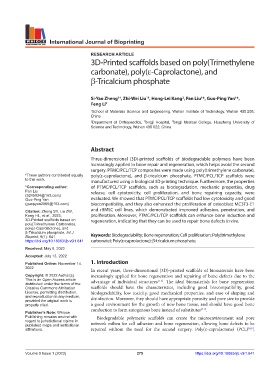Page 283 - IJB-9-1
P. 283
International Journal of Bioprinting
RESEARCH ARTICLE
3D-Printed scaffolds based on poly(Trimethylene
carbonate), poly(ε-Caprolactone), and
β-Tricalcium phosphate
1†
1†
2
Si-Yao Zheng , Zhi-Wei Liu , Hong-Lei Kang , Fan Liu *, Guo-Ping Yan *,
1
1
Feng Li 2
1 School of Materials Science and Engineering, Wuhan Institute of Technology, Wuhan 430 205,
China
2 Department of Orthopaedics, Tongji Hospital, Tongji Medical College, Huazhong University of
Science and Technology, Wuhan 430 022, China
Abstract
Three-dimensional (3D)-printed scaffolds of biodegradable polymers have been
increasingly applied in bone repair and regeneration, which helps avoid the second
surgery. PTMC/PCL/TCP composites were made using poly(trimethylene carbonate),
† These authors contributed equally poly(ε-caprolactone), and β-tricalcium phosphate. PTMC/PCL/TCP scaffolds were
to this work. manufactured using a biological 3D printing technique. Furthermore, the properties
*Corresponding author: of PTMC/PCL/TCP scaffolds, such as biodegradation, mechanic properties, drug
Fan Liu release, cell cytotoxicity, cell proliferation, and bone repairing capacity, were
(5245934@163.com)
Guo-Ping Yan evaluated. We showed that PTMC/PCL/TCP scaffolds had low cytotoxicity and good
(guopyan2006@163.com) biocompatibility, and they also enhanced the proliferation of osteoblast MC3T3-E1
Citation: Zheng SY, Liu ZW, and rBMSC cell lines, which demonstrated improved adhesion, penetration, and
Kang HL, et al., 2023, proliferation. Moreover, PTMC/PCL/TCP scaffolds can enhance bone induction and
3D-Printed scaffolds based on regeneration, indicating that they can be used to repair bone defects in vivo.
poly(Trimethylene Carbonate),
poly(ε-Caprolactone), and
β-Tricalcium phosphate, Int J
Bioprint, 9(1): 641. Keywords: Biodegradability; Bone regeneration; Cell proliferation; Poly(trimethylene
https://doi.org/10.18063/ijb.v9i1.641 carbonate); Poly(ε-caprolactone); β-tricalcium phosphate.
Received: May 8, 2022
Accepted: July 13, 2022
Published Online: November 14, 1. Introduction
2022
In recent years, three-dimensional (3D)-printed scaffolds of biomaterials have been
Copyright: © 2022 Author(s). increasingly applied for bone regeneration and repairing of bone defects due to the
This is an Open Access article advantage of individual structures [1-3] . The ideal biomaterials for bone regeneration
distributed under the terms of the
Creative Commons Attribution scaffolds should have the characteristics, including good biocompatibility, good
License, permitting distribution, biodegradability, low toxicity, good mechanical properties, and ease of shaping and
and reproduction in any medium, disinfection. Moreover, they should have appropriate porosity and pore size to provide
provided the original work is
properly cited. a good environment for the growth of new bone tissue, and should have good bone
conduction to form autogenous bone instead of substitutes [4-7] .
Publisher’s Note: Whioce
Publishing remains neutral with Biodegradable polymeric scaffolds can create the microenvironment and pore
regard to jurisdictional claims in
published maps and institutional network milieu for cell adhesion and bone regeneration, allowing bone defects to be
affiliations. repaired without the need for the second surgery. Poly(ε-caprolactone) (PCL) [8,9] ,
Volume 9 Issue 1 (2023) 275 https://doi.org/10.18063/ijb.v9i1.641

